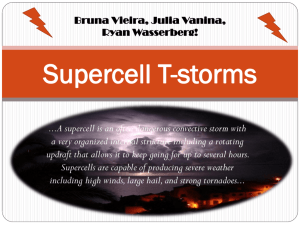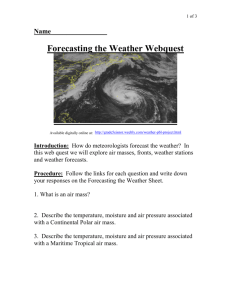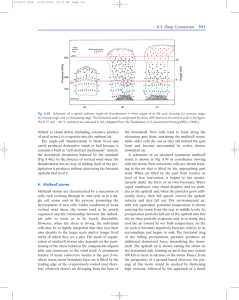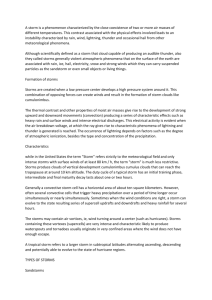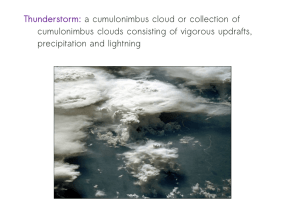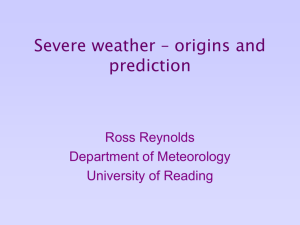Chapter 3 Convective Dynamics
advertisement
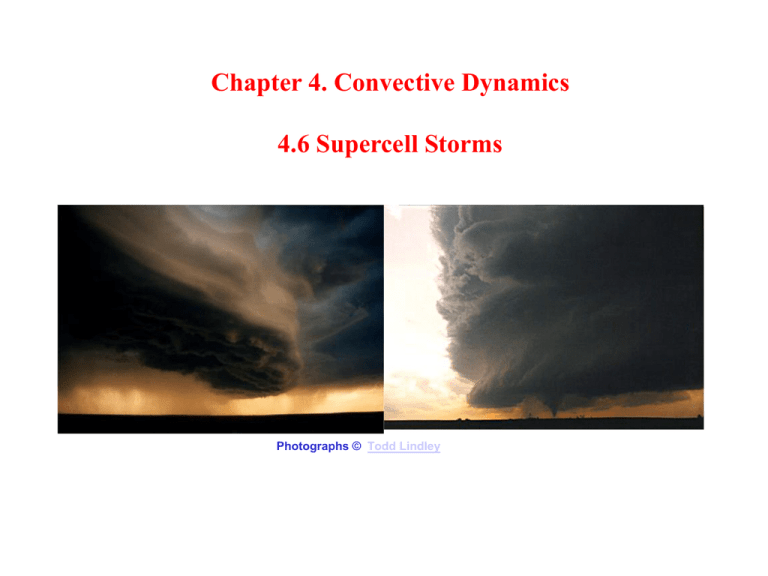
Chapter 4. Convective Dynamics 4.6 Supercell Storms Photographs © Todd Lindley Introduction • A supercell storm is defined as a thunderstorm with a deep rotating updraft. • Supercell thunderstorms are perhaps the most violent of all thunderstorm types, and are capable of producing damaging winds, large hail, and weak-toviolent tornadoes. • They are most common during the spring across the central United States when moderate-to-strong atmospheric wind fields, vertical wind shear and instability are present. • The degree and vertical distribution of moisture, instability, lift, and especially wind shear have a profound influence on convective storm type. • Once thunderstorms form, small/convective-scale interactions also influence storm type and evolution. • There are variations of supercells, including "classic," "miniature," "high precipitation (HP)," and "low precipitation (LP)" storms. • In general, however, the supercell class of storms is defined by a persistent rotating updraft (i.e., meso-cyclone) which promotes storm organization, maintenance, and severity. Supercell Thunderstorms A very large storm with one principal updraft Quasi-steady in physical structure – Continuous updraft – Continuous downdraft – Persistent updraft/downdraft couplet Rotating Updraft --- Mesocyclone Lifetime of several hours Highly three-dimensional in structure 4 Supercell Thunderstorms Potentially the most dangerous of all the convective types of storms Often cause – High winds – Large and damaging hail – Frequent lightning – Large and long-lived tornadoes 5 Supercell Thunderstorms Form in an environment of strong winds and high shear – Provides a mechanism for separating the updraft and downdraft • The distinguishing feature of supercells is that the updraft and downdraft remain separated such that they feed on each other. 6 Structure of Classic Supercell Storm – Horizontal cross-section • A horizontal, low-level cross-section of a "classic" supercell. • The storm is characterized by a large precipitation area on radar, and a pendant or hook-shaped echo wrapping cyclonically around the updraft area. Note the position of the updraft and the gust front wave. • The intense updraft suspends precipitation particles above it, with rain and hail eventually blown off of the updraft summit and downwind by the strong winds aloft. • Updraft rotation results in the gust front wave pattern, with warm surface air supplying a continual feed of moisture to the storm. Supercell Structure Forward Flank Downdraft Tornado Rear Flank Downdraft Flanking Line/ Gust Front Mesocyclone Gustnado Inflow From: Bluestein, Synoptic-Dynamic Meteorology -- Volume II Structure of Classic Supercell Storm - Side view • A westward view of the classic supercell reveals the wall cloud beneath the intense updraft core and an inflow tail cloud on the rainy downdraft side of the wall cloud. Wall clouds tend to develop beneath the north side of the supercell rain-free base, although other configurations occur. • Observe the nearly vertical, "vaulted" appearance of the cloud boundary on the north side of the Cb and adjacent to the visible precipitation area. A sharp boundary between downdraft and rotating updraft results in this appearance. • Note the anvil overhang on the upwind (southwest) side of the storm and the overshooting top, both visual clues as to the intensity of the updraft. A Supercell on NEXRAD Doppler Radar Hook Echo 10 Supercell Types Classic Low-precipitation High-precipitation 11 Classic Supercells Traditional conceptual model of supercells Usually some precipitation but not usually torrential Reflectivities in the hook are usually less than those in the core Rotation is usually seen both visually and on radar 12 Classic Supercells © 1993 American Geophysical Union -- From: Church et al., The Tornado 13 Classic Supercells © 1993 American Geophysical Union -- From: Church et al., The Tornado 14 Classic Supercell Heaviest Precipitation (core) Hook 15 Low Precipitation (LP) Supercells Little or no visible precipitation Clearly show rotation Cloud base is easily seen and is often small in diameter Radar may not indicate rotation in the storm although they may have a persistent rotation LP storms are frequently non-tornadic LP storms are frequently non-severe 16 LP Supercell Side View Schematic © 1993 American Geophysical Union -- From: Church et al., The Tornado 17 LP Supercell Top View Schematic © 1993 American Geophysical Union -- From: Church et al., The Tornado 18 LP Supercell © 1995 Robert Prentice 19 LP Supercell © 1995 Robert Prentice 20 Another LP Supercell © 1993 Oxford University Press -- From: Bluestein, Synoptic-Dynamic Meteorology -- Volume II: Observations and Theory of Weather Systems 21 A Tornadic LP Supercell 26 May 1994 -- Texas Panhandle 22 © 1998 Prentice-Hall, Inc. -- From: Lutgens and Tarbuck, The Atmosphere, 7th Ed. High Precipitation (HP) Supercells Substantial precipitation in mesocyclone May have a recognizable hook echo on radar (many do not, however) Reflectivities in the hook are comparable to those in the core Most common form of supercell May produce torrential, flood-producing rain Visible sign of rotation may be difficult to detect -- Easily detected by radar 23 HP Supercells © 1993 American Geophysical Union -- From: Church et al., The Tornado 24 HP Supercells © 1993 American Geophysical Union -- From: Church et al., The Tornado 25 HP Supercell Heaviest Precipitation (core) Kansas Woods County, Oklahoma Oklahoma 4 OCT 1998 2120 UTC KTLX 26 Heaviest Precipitation (core) Twenty minutes later ….. Kansas Oklahoma HP Supercell 4 OCT 1998 2150 UTC KTLX Developing Cells 27 Hybrids Class distinctions are much less obvious in the real world! Visibly a storm may look different on radar than it does in person -- makes storms difficult to classify Supercells often evolve from LP Classic HP. There is a continuous spectrum of storm types. 28 Supercell Evolution Early Phase – Initial cell development is essentially identical to that of a short-lived single cell storm. – Radar reflectivity is vertically stacked – Motion of the storm is generally in the direction of the mean wind – Storm shape is circular (from above) and symmetrical 29 Supercell Evolution -- Early Phase Side View Top View Heaviest Precipitation © 1993 Oxford University Press -- From: Bluestein, Synoptic-Dynamic Meteorology -- Volume II: Observations and Theory of Weather Systems 30 Supercell Evolution Middle Phase – As the storm develops, the strong wind shear alters the storm characteristics from that of a single cell – The reflectivity pattern is elongated down wind -- the stronger winds aloft blow the precipitation – The strongest reflectivity gradient is usually along the SW corner of the storm – Instead of being vertical, the updraft and downdraft become separated 31 Supercell Evolution Middle Phase – After about an hour, the radar pattern indicates a “weak echo region” (WER) – This tells us that the updraft is strong and scours out precipitation from the updraft – Precipitation aloft “overhangs” a rain free region at the bottom of the storm. – The storm starts to turn to the right of the mean wind into the supply of warm, moist air 32 Supercell Evolution -- Middle Phase Side View Top View Heaviest Precipitation © 1993 Oxford University Press -- From: Bluestein, Synoptic-Dynamic Meteorology -- Volume II: Observations and Theory of Weather Systems 33 Supercell Evolution Mature Phase – After about 90 minutes, the storm has reached a quasi-steady mature phase – Rotation is now evident and a mesocyclone (the rotating updraft) has started – This rotation (usually CCW) creates a hook-like appendage on the southwest flank of the storm 34 Supercell Evolution -- Mature Phase Side View Top View Hook Heaviest Precipitation © 1993 Oxford University Press -- From: Bluestein, Synoptic-Dynamic Meteorology -- Volume II: Observations and Theory of Weather Systems 35 Supercell Evolution -- Mature Phase Hook Echo 36 Supercell Evolution Mature Phase – The updraft increases in strength and more precipitation, including hail, is held aloft and scoured out of the updraft – As the storm produces more precipitation, the weak echo region, at some midlevels, becomes “bounded” – This bounded weak echo region (BWER), or “vault,” resembles (on radar) a hole of no precipitation surrounded by a ring of precipitation 37 Supercell Evolution -- Mature Phase Slice 4 km Bounded Weak Echo Region © 1990 *Aster Press -- From: Cotton, Storms 38 Splitting Storms If the shear is favorable (often a straight line hodograph), the storm often tends to split into two new storms. If the hodograph is curved CW, the southern storm is favored. If the hodograph is curved CCW, the northern storm is favored. 39 Splitting Storms © 1990 *Aster Press -- From: Cotton, Storms 40 Left Mover Splitting Storms Split Right Mover © 1993 Oxford University Press -- From: Bluestein, Synoptic-Dynamic Meteorology -- Volume II: Observations and Theory of Weather Systems 41 Updraft The updraft is the rising column of air in the supercell They are generally located on the front or right side of the storm Entrainment is small in the core of the updraft Updraft speeds may reach 50 m s-1!!! Radar indicates that the strongest updrafts occur in the middle and upper parts of the storm 42 Updraft Factors affecting the updraft speed – Buoyancy » The more unstable the air, the larger the buoyancy of the parcel as they rise in the atmosphere » The larger the temperature difference between the parcel and the environment, the greater the buoyancy and the faster the updraft – Vertical pressure gradients » Small effect but locally important » Regions of local convergence can result in local areas of increased pressure gradients » Updraft rotation creates upwards VPGF at lower levels – Turbulence » Turbulence reduces updraft intensity 43 Rotating Updrafts - Visual Clue The circular mid-level cloud bands and the smooth, cylindrical Cb strongly hint of updraft rotation. Above the mid-level cloud band, an extremely hard Cb top is barely visible (upper right) towering into the anvil. Note the smooth, "laminar" flanking line on the extreme left. A strong, "capping" temperature inversion in the low levels probably accounted for the laminar appearance of the flank. 44 Structure of a Supercell Storm MesoCyclone 45 Wall Clouds - a lowering cloud base • It is believed that wall clouds develop when some rain-cooled air is pulled upward, along with the more buoyant air. • The rain-cooled air is very humid, and upon being lifted it quickly saturates to form the lowered cloud base. • Thus, the wall cloud probably develop sometime after an intense storm begins to precipitate. 47 The Wall Cloud MesoCyclone 48 The Wall Cloud MesoCyclone 49 The Wall Cloud 50 The Wall Cloud 51 The Wall Cloud 52 Supercell Downdrafts The same forces that affect updrafts also help to initiate, maintain, or dissipate downdrafts: – Vertical PGF – Buoyancy (including precipitation loading) – Turbulence Downdraft wind speeds may exceed 40 m s-1 53 Supercell Downdrafts We shall examine two distinct downdrafts associated with supercell thunderstorms: – Forward Flank Downdraft (FFD) – Rear Flank Downdraft (RFD) 54 Supercell Downdrafts Forward Flank Downdraft Rear Flank Downdraft Inflow © 1993 Oxford University Press -- From: Bluestein, Synoptic-Dynamic Meteorology -- Volume II: Observations and Theory of Weather Systems 55 Forward Flank Downdraft Associated with the heavy precipitation core of supercells. Air in the downdraft originates within the column of precipitation as well as below the cloud base where evaporational cooling is important. Forms in the forward flank (with respect to storm motion) of the storm. FFD air spreads out when it hits the ground and forms a gust front. 56 Rear Flank Downdraft Forms at the rear, or upshear, side of the storm. Result of the storm “blocking” the flow of ambient air. Maintained and enhanced by the evaporation of anvil precipitation. Enhanced by mid-level dry air entrainment and associated evaporational cooling. Located adjacent to the updraft. 57 Formation of the RFD Imagine a river flowing straight in a smooth channel. The water down the center flows smoothly at essentially a constant speed. The pressure down the center of the channel is constant along the channel. 58 Formation of the RFD Let us now place a large rock in the center of the channel. The water must flow around the rock. A region of high pressure forms at the front edge of the rock -- Here the water moves slowly -- Stagnation Point 59 Formation of the RFD This happens in the atmosphere also! The updraft acts a an obstruction to the upper level flow. 60 Formation of the RFD The RFD descends, with the help of evaporatively cooled air, to the ground. When it hits the ground, it forms a gust front. Upper-level Flow Updraft FFD RFD Mid-level Flow Gust Front Inflow 61 Bernoulli’s Equation v2 constant along streamline 2 p • Where velocity us low, pressure is high Supercell Storm Dynamics • Environmental Conditions and Storm Types • Early Development of Rotation • Storm Splitting • Helicity • Tornadic Phase of Supercell Storms Effect of Environment on Storm Types • CAPE and Vertical Environmental Wind Shear are the two most important environmental factors determining the storm types • Numerical models have been very effective tools to understand such effects • In general, single cell storms occur in environment with little vertical shear • Multicell storms occur in environment with moderate vertical shear • Supercell storms occur in environment with strong vertical shear Numerical Experiments of Weisman and Klemp (1982) Vertical wind profiles with unidirectional shear of different magnitudes Time series of max w for 5 experiments Supercell behavior is observed with us =25, 35 and 45m/s cases – quasi-steady updraft is found Results from u = 15m/s and 35 m/s cases • Multicell case (left) with u =15 m/s and supercell case (right) with u = 35m/s. • One the southern half of the computational domain is shown because the fields are symmetric about the central E-W axis • The splitting of the initial storm into two (only the southern member is shown). • The storm splitting is a result of rotational storm dynamics (more later). The member that moves to the right of vertical shear vector is called right mover, and the other the left mover. • When the shear is not unidirectional, i.e., when shear changes direction with height, one of the member will be favored, again due to rotational storm dynamics Maximum w as a function of CAPE and shear • The vertical axis is the low-level qv – higher value corresponds to higher CAPE • First cell intensity increases with CAPE and decreases with shear • Second cell occurs only with moderate shear. • Supercell storm occurs in stronger vertical shear. • Strong updraft can survive in supercells because of the support of pressure perturbations associated with vertical rotation which initially comes from horizontal vorticity in the environment via tilting. Multicell case Supercell case Generation of vertical vorticity via tilting
